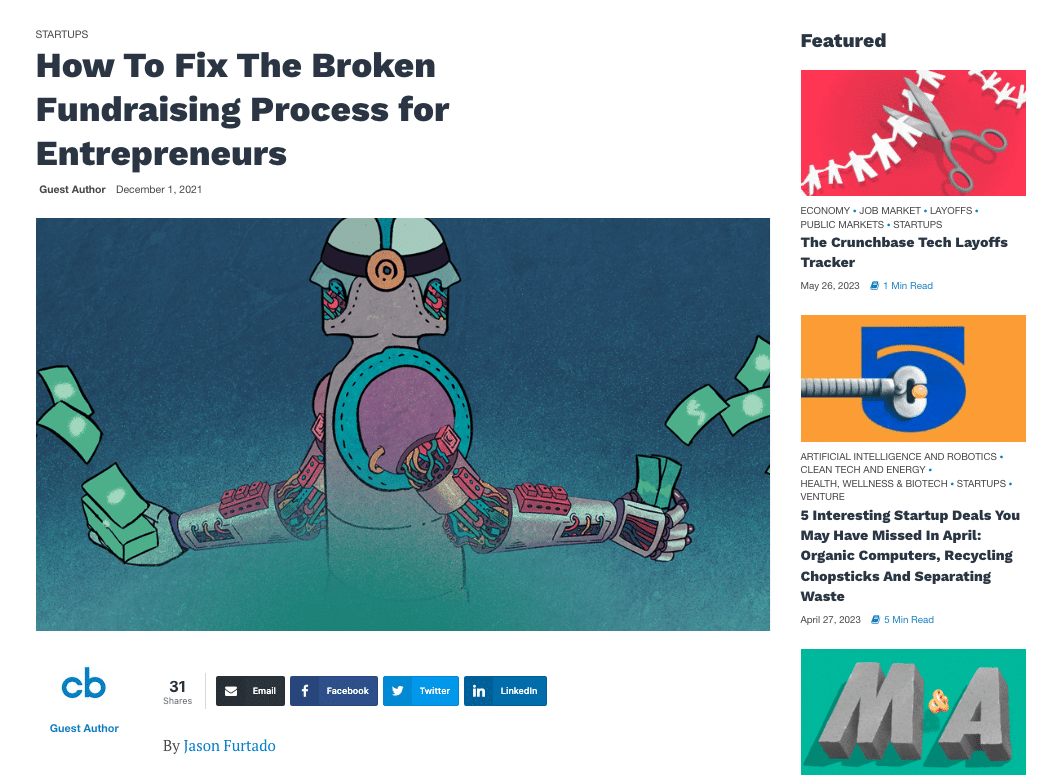Thought leadership content is a great way to show off your expertise, grow your network and boost brand awareness for your company.
As a founder or executive in a high-growth technology company, you likely use your expertise to help customers and drive revenue every day. That qualifies you as a subject matter expert.
What if you could capture some of that expertise and share it with a relevant community or audience?
That’s what thought leadership articles are all about.
In This Article
- What Is Thought Leadership Content?
- Qualities of a Great Thought Leadership Content Strategy
- How to Create Thought Leadership Content
- Thought Leadership Content Examples
What Is Thought Leadership Content?
Thought leadership content is written, audio or visual media that companies use to set themselves apart by demonstrating expertise and sharing unique perspectives on a particular topic of interest to their target audience. Thought leadership provides value that audiences can’t get anywhere else.
Thought leadership articles are usually authored by a particular executive or another employee, with that person’s name as the byline. If you have a marketing professional on your team, they might help with the writing process.
In many cases, companies will pitch these articles to media outlets, hoping that the idea gains traction with a new audience. But it’s also fine to post these ideas on your own as blog posts or long-form LinkedIn articles, either on your company page or your personal profile.
A successful and well-executed thought leadership content strategy can help:
- position your company as an authority on a certain topic;
- boost brand awareness; and
- expose you to potential new customers, investors and partners.
Thought Leadership Playbook
Qualities of a Great Thought Leadership Content Strategy
Great thought leadership content tends to share four qualities:
- Original: Readers want something new — not a regurgitated thought or an explanation of a widely held belief. Try to take a new stance. If you’re writing about a common topic, develop a nuanced perspective.
- Thought-provoking: Make your audience feel something while they read. Don’t be afraid to challenge norms and address problems in your industry.
- Predictive: Don’t stop at “This trend is happening…” Tell your audience how things will continue to change or what trend is coming up next.
- Non-promotional: This holds true for any thought leadership articles that will be pitched to a media outlet. Your goal is to share expertise, not promote your own product or service. Avoid phrasing such as “At our company, we’re doing XYZ.” If you’re posting on your company’s blog or on owned social channels, it’s fine to be a bit more promotional — but keep focused on the big idea.
How to Create Thought Leadership Content
Creating thought leadership content is a five-step process:
- Idea Generation and Brainstorming
- Outlining and Writing
- Editing
- Pitching
- Promoting and Repurposing
1. Idea Generation and Brainstorming
You’ve got to start somewhere!
Start by identifying your topic. Perhaps you have an overarching take on your industry, a technical insight related to your market or a strategy for customer acquisition. Next up:
Set up a brainstorming session. Don’t be afraid to ask a friend or colleague to brainstorm the idea with you. Oftentimes, we do our best thinking in a free-flowing conversation. Try recording yourself to capture those off-hand pearls of wisdom.
Be prepared but flexible. Let your big idea come to you. You might start with an idea in mind, but as you speak, something new pops into your head.
2. Outlining and Writing
Now it’s your job to turn a conversation into a coherent article.
Build an outline. This isn’t always necessary, but it can be helpful. Make sure you’re on the right track before you spend hours writing.
Write for your intended audience. Speak the language of your target audience, even if you’re not sure which media outlets will be interested in your post just yet.
Write a blurb about yourself. This blurb is a helpful paragraph for the beginning or end of your article. It may seem unnatural to speak about your role, background, previous accomplishments, etc., but it’s important for the audience to know why they should trust your take on this topic.
3. Editing
It’s always helpful to have another set of eyes on your article.
Find a trusted editor. Whether that’s a friend, colleague, marketing pro, etc, you’ll need someone who can give you honest feedback.
Don’t over-edit. Try to keep your editing circle small; the more people involved, the harder it is to agree on a final draft. Perfect is often the enemy of good; a few thoughtful drafts are better than several back-and-forths.
4. Pitching
Not all thought leadership content will be pitched to a media outlet; it’s perfectly fine to publish the articles on your own channels. If you are seeking media involvement, it’s best to:
Write an abstract. Send a short email that quickly summarizes your article and why it would resonate with a media outlet’s audience. Journalists prefer email pitches that are 100 words or less, but only 13% of pitches are this length, according to Plotlights.
Target niche/industry outlets. Even if you write a spectacular post, Forbes and TechCrunch probably won’t be able to publish it. And many large outlets operate on a pay-to-play structure. For free engagements, target smaller news outlets and trade publications that your target audience is likely to visit. If you’re writing about development, go to dev publications. If you’re dishing on MarTech, look to an outlet that appeals to marketing professionals.
Build relationships with reporters. A media outlet might decline your thought leadership article. Maybe it wasn’t the right fit, or the timing was poor. Maintain good relationships in case your next piece is up their alley.
5. Promoting and Repurposing
Thought leadership content can only be groundbreaking if it’s read and shared by many.
Share through owned channels. Start by promoting your article on your own social media channels – whether that’s a personal LinkedIn profile or your company’s account. Include enough information in your social copy to get the message across on its own.
Be a good partner. If your media outlet partner is posting the story, be sure to comment and like their posts. Don’t be afraid to drop the link in the comments of other relevant posts as well. This helps position your company in the conversation.
Find ways to repurpose your content. You’ve worked hard on your thought leadership; don’t let it fade after one post. Break up the content into smaller pieces for social media, record a podcast rehashing the idea or add a unique spin to generate a company blog post. Now is your chance to be promotional through your owned channels.
4 Thought Leadership Content Examples
Here are four thought leadership content examples published by York IE’s Advisory as a Service clients:
- Outlet: Crunchbase News
- Author: Jason Furtado, CEO and co-founder, Shoobx
- Outlet: BuiltIn
- Author: Scott Smith, CEO, CloudApp
- Outlet: Quirks Media
- Author: Nitzan Shaer, CEO and co-founder, WEVO
- Outlet: LinkedIn
- Author: Michael Sheeley, CEO and co-founder, Nurse-1-1
Getting Started with Thought Leadership Content
Now that you’ve read some thought leadership content examples, it’s time to give yourself a platform to share your unique perspectives. Start jotting down your ideas, grab a friend to brainstorm with and get started!











